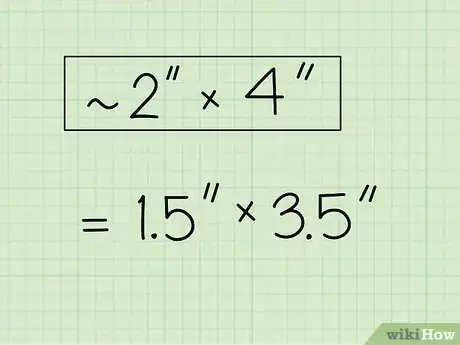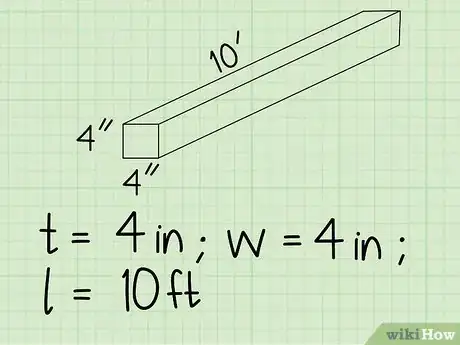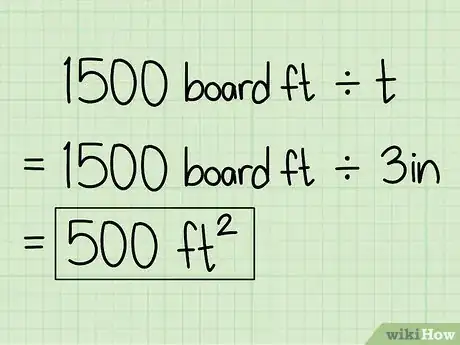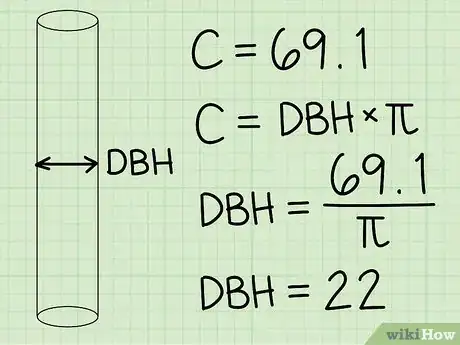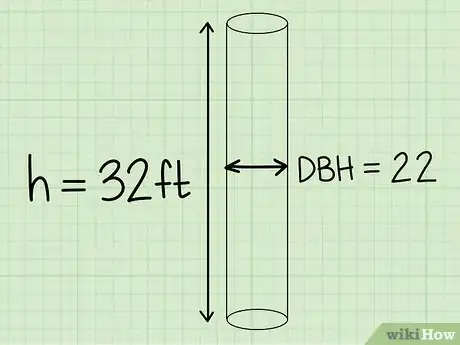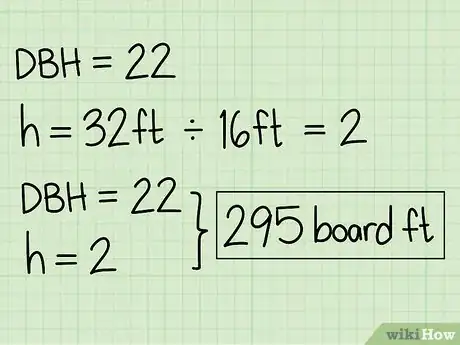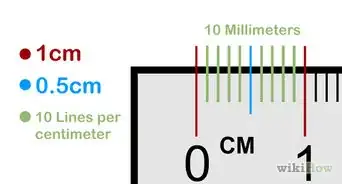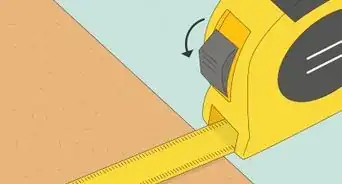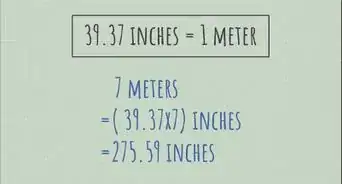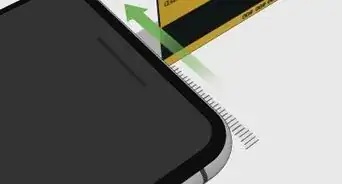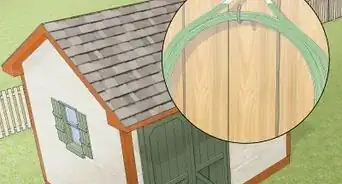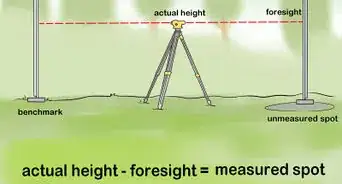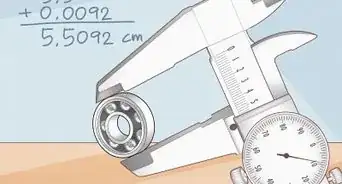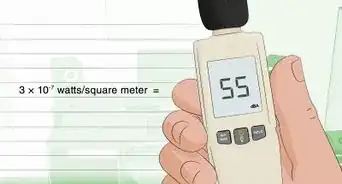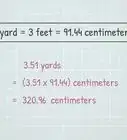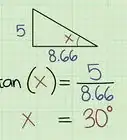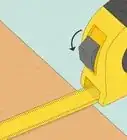This article was co-authored by wikiHow staff writer, Sophia Latorre. Sophia Latorre is a Content Manager on the wikiHow team. Before joining wikiHow, Sophia worked as a technical editor and was published in six International Energy Agency (IEA) Wind Annual Reports. Now, she writes, edits, and reviews articles for the wikiHow Content Team, working to make the content as helpful as possible for readers worldwide. Sophia holds a BA in English from Colorado State University.
wikiHow marks an article as reader-approved once it receives enough positive feedback. In this case, several readers have written to tell us that this article was helpful to them, earning it our reader-approved status.
This article has been viewed 413,905 times.
Learn more...
Board feet is a measurement of the volume of lumber, often used by wholesalers and sawmills in Canada and the United States. A single board foot is equivalent to 1 square foot of lumber that is 1 inch thick, meaning it has a length of 12 inches, a width of 12 inches, and a thickness of 1 inch.[1] While it may seem confusing, it’s actually pretty easy to calculate how many board feet of lumber you need for any project. If you need to know how many board feet are in a tree or log, simply find the diameter and height or length and plug your measurements into the Doyle scale.
Steps
Finding the Volume of Boards
-
1Use the rough size of the boards rather than the actual size. The rough, or nominal, size of a board refers to the dimensions the manufacturer will supply you with, such as “2 x 4” which means 2 inches by 4 inches. However, after processing, the board’s actual measurements are closer to 1.5 inches by 3.5 inches. When calculating board feet, always use the rough size to get an accurate result.[2]
-
2Measure the thickness and width in inches and the length in feet. Use your measuring tape to find both the thickness and the width of the board in inches. Then, find the length in feet rather than inches, since that is how lumber is typically measured. If you know the size of the boards you’ll be using, you can use the provided dimensions instead of measuring the boards.[3]
- For example, a 4 x 4 has a thickness of 4 inches and a width of 4 inches. If the board is 10 feet long, that’s the length.
Advertisement -
3Multiply the thickness by the width by the length and divide the result by 12. Start by taking all 3 measurements and multiplying them together. For this example, 4 x 4 x 10 = 160. To finish the calculation, just divide by 12. In this case, 160 ÷ 12 = 13.33, so you need 13.33 board feet of lumber.
- If you have multiple boards that are the same size, do the entire calculation for a single board and multiply it by the number of boards you need. For instance, if you have 20 boards that are 2 inches by 6 inches by 8 feet, multiply 2 by 6 by 8, which equals 96. Divide 96 by 12, which is 8 (the number of board feet in a single board of this size). Multiply 8 by 20, which is 160, to find the total board feet.
Variation: If you measured the length in inches rather than feet, such as if you have a very short board, multiply the dimensions of the board together as usual but divide the result by 144 instead of 12.[4]
-
4Convert board feet to square feet by dividing by the thickness in inches. If you’re given the volume of lumber in board feet, you can easily figure out the square footage the boards will cover. Remember that volume is a three-dimensional measurement while square footage is a two-dimensional measurement. Take the total board feet and divide it by the thickness, in inches, of the boards.[5]
- For example, say you have 1,500 board feet of lumber. If the boards are 3 inches thick, divide 1,500 by 3, which is equal to 500. So, 1,500 board feet is equivalent to 500 square feet.
Estimating Board Feet in a Tree or Log
-
1Measure the diameter of the tree or the log inside the bark. Use a flexible measuring tape, tree diameter tape, tree caliper, or Biltmore stick to find the diameter of the tree at breast height (DBH), or about 4.5 feet above the ground. If you’re working with a cut log, measure the diameter inside the bark (DIB) at the small end of the log.[6]
Tip: If you’re using a flexible measuring tape, find the circumference of the tree, then divide the circumference by π (3.14) to calculate the diameter.
-
2Find the height of the tree or the length of the log in feet. Use your measuring device to find the height or length. Tree height is generally measured in 16-foot increments in order to estimate board feet. Log length is typically measured in 2-foot increments, such as 6 feet, 8 feet, 10 feet, and so on.[7]
-
3Plug your measurements into the Doyle scale. The Doyle scale is most often used to calculate board feet in a tree or log. All you need to do is plug in the diameter at breast height (DBH) and number of 16-foot logs in a tree or the diameter inside the bark (DIB) at the small end of the log and the log length in feet to figure out the volume in board feet.[8]
- You can find the Doyle scale table here: https://nfs.unl.edu/documents/ruralforestry/tree%20and%20log%20scale%20Doyle%20WEB.pdf
- Say the DBH is 22 and the height is 32 feet, or that there are 2 16-foot logs in the tree. Using the Doyle scale, you'd find that there are 295 board feet in the tree.
- Alternatively, say that the DIB is 35 and the log is 10 feet long. Based on the Doyle scale, the volume in board feet for the log is 601.
Community Q&A
-
QuestionWhat is the board feet in a beam that is 20 feet long, 14 inches wide and 8 inches thick?
 Community Answer186 and 2/3 board feet. The formula is (Width x length x thickness) / 144. All measurements must be converted to inches for this formula to work. You can also convert to feet first and then leave out the division by 144.
Community Answer186 and 2/3 board feet. The formula is (Width x length x thickness) / 144. All measurements must be converted to inches for this formula to work. You can also convert to feet first and then leave out the division by 144. -
QuestionHow do I calculate the board feet if I know the number of pieces, thickness, and width?
 Community AnswerYou will also need to know length.
Community AnswerYou will also need to know length. -
QuestionHow do I estimate board if I know the pricing per foot?
 Community AnswerMultiply the length of your board by the price of a foot. These are dimensional boards and are priced by foot rather than board feet. It's a linear pricing rather than a volume pricing.
Community AnswerMultiply the length of your board by the price of a foot. These are dimensional boards and are priced by foot rather than board feet. It's a linear pricing rather than a volume pricing.
References
- ↑ http://education.mnhs.org/video/lumberjack-timber-cruiser/calculating-board-feet
- ↑ http://www.harvarddesignmagazine.org/issues/45/nominal-versus-actual-a-history-of-the-2x4
- ↑ https://www.todayshomeowner.com/board-foot-calculator/
- ↑ https://ohioline.osu.edu/factsheet/F-35-02
- ↑ https://www.reference.com/science/convert-board-feet-square-feet-f1c765e9e33c2c6e
- ↑ https://ohioline.osu.edu/factsheet/F-35-02
- ↑ https://ohioline.osu.edu/factsheet/F-35-02
- ↑ https://ohioline.osu.edu/factsheet/F-35-02
About This Article
To calculate board feet, start by using a measuring tape to measure the thickness and width of the board in inches and the length in feet. Next, multiply all 3 measurements together to get the board's volume. Finally, divide the volume by 12 to calculate board feet. If the board you're working with is short, you can measure the length in inches rather than feet. Then, multiply the 3 numbers together and divide the answer by 144 instead of 12 to complete the equation. To learn how to convert board feet to square feet, read on!
